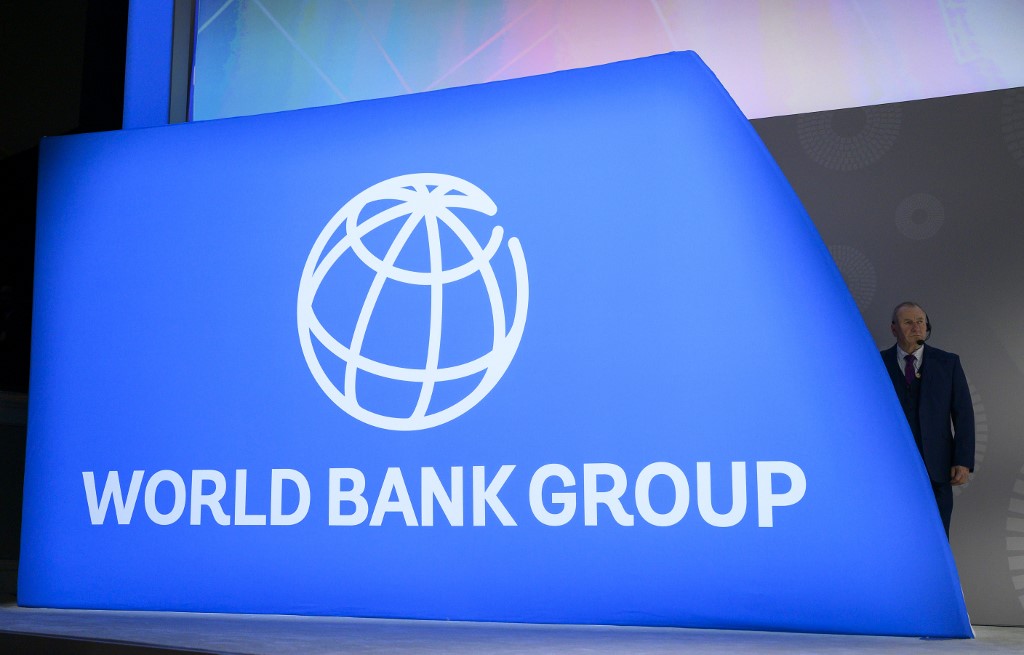WB sees external dark clouds hovering over PH economy

A stage director looks on at the IMF/World Bank Annual Fall Meetings Plenary Session in Washington, DC, on October 18, 2019. (Photo by Andrew CABALLERO-REYNOLDS / AFP)
MANILA, Philippines—The World Bank expects the Philippines this year to match last year’s economic growth rate of 5.7 percent, although below the government’s goal amid lingering global risks spilling over locally.
The Washington-based multilateral lender’s Philippine Economic Update report released on Wednesday (June 8) kept its gross domestic product (GDP) growth forecast in April, which was nonetheless less optimistic than the 5.9-percent 2022 growth projection it made in 2021. The estimate remained below the narrowed 7 to 8 percent target range of the Development Budget Coordination Committee (DBCC).
“The external environment has turned less favorable at a time when the Philippines has weathered the worst so far of the pandemic,” said Kevin Chua, WB senior Philippine economist, at a press briefing.
“Three international developments are putting pressure on the domestic economy. These are the war in Ukraine, the tightening of global financing conditions, and the growth deceleration in the country’s main trading partners,” Chua said.
In particular, Chua noted that Russia’s invasion of Ukraine jacked up global oil and commodity prices, which also jumped locally. “Global commodity prices have increased since January by more than 50 percent for both oil and wheat.”
For Chua, “taming inflation is a pressing concern as it can dampen consumption and worsen poverty.” Headline inflation climbed to a 42-month high of 5.4 percent year-on-year in May, bringing the five-month average to 4.1 percent or above the government’s 2 to 4 percent target band of manageable price hikes conducive to economic growth.
If the Russia-Ukraine conflict dragged on, the World Bank said in a statement that “estimates of the direct effects of prices variations on poverty, show that a 10 percent increase in the global price of cereals is expected to raise the poverty headcount by 1 percentage point (ppt), pushing an additional 1.1 million Filipinos into poverty.”
“An increase of 10 percent in energy prices, on the other hand, is estimated to raise the poverty headcount by 0.3 percentage points, equivalent to an added 329,000 Filipinos into poverty,” the World Bank added.
“Authorities have to use all available policy tools to address inflation, including monetary measures to prevent the de-anchoring of inflation expectations, and supply-side measures such as importation and lower tariffs and non-tariff barriers for important commodities to help augment domestic supplies as needed, and greater support to agriculture production through extension services, seeds, and fertilizer,” Chua said.
“Social assistance will continue to play an important role in protecting poor and vulnerable households from high inflation and global uncertainties. However, given the tight budget situation affecting the government, social assistance needs to be timely and targeted. Improving delivery of social assistance using digital technologies can ensure that assistance will reach those most in need,” the World Bank said.
It did not help that rising interest rates worldwide could dampen the Philippines’ investment prospects, alongside China’s economic slowdown — partly due to its stringent zero COVID-19 policy — which Chua said “adversely impacts the Philippines as its trade is increasingly oriented towards the Chinese markets.”
Despite an external environment which Chua described as “weak” and “unfavorable,” he said the Philippine economy can bounce back mainly through more robust domestic activity. “The Philippine growth outlook is positive — it is poised to be among the key growth performers in the East Asia region this year,” Chua said.
The World Bank’s separate Global Economic Prospects report released Tuesday (June 7) night showed its 2022 growth forecast for the Philippines was the third fastest in East Asia and the Pacific, only behind Fiji’s 6.3 percent and Vietnam’s 5.8 percent.
Despite the Philippines’ better-than-expected first-quarter GDP expansion of 8.3 percent year-on-year, Chua lamented that “the recovery is uneven across sectors.”
“While most sectors have caught up to their pre-pandemic levels, some such as accommodation, food services, and transport and storage have yet to return to their pre-pandemic output levels in 2019. Moreover, amid the pandemic, smaller firms and firms in these sectors have shown higher rates of closure. These are indicative that the recovery has been uneven across firms and sectors,” Chua said.
But moving forward, Chua said that “growth will draw strength from an improving domestic environment, characterized by declining COVID-19 cases, more vigorous public mobility, and wider economic reopening.”
“Following current growth projections, poverty incidence is projected to decrease to 21 percent in 2022 and continue to decline through 2024 using the $3.20 per day in PPP [purchasing power parity],” Chua said.
“Poverty will likely decline faster in major economic centers in Luzon than in the rest of the country because of faster employment growth. Recent official employment statistics suggest that sectors associated with rural employment are recovering slower than other sectors, indicating that poverty reduction will likely be slower in rural areas,” he said.
“Still, the looming uncertainties on the ongoing war in Ukraine will slow down the decline in poverty mainly due to the direct effect of higher food prices and the knock-on effect of fuel price increases. For households in the poorest decile, food consumption accounts for 64 percent of total household consumption, with cereals alone comprising 44 percent of total consumption,” he added.
Also, Chua said more needs to be done to not only revert the quantity of jobs to pre-pandemic levels but also return their better quality.
